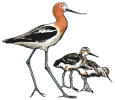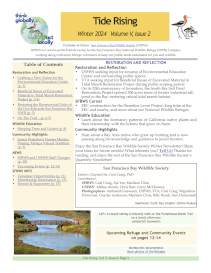National Wildflower Week: May 3 - 9, 2021 - The Value of Native Plants
The first full week of May is National Wildflower Week, May 3 through 9 this year. It is a time when most of the country is ablaze with springtime blossoms.
While taking a walk around your neighborhood or driving along the freeway, a patch of California Poppies, with bright orange petals and lime green foliage, might catch your attention.
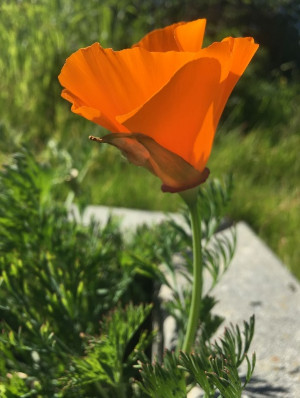
California Poppy. Photo Credit: Hope Presley / SFBWS
The California Poppy is the state’s designated flower, and it’s a shining example of California’s amazing collection of plants.
California has the highest number of native and endemic plants than any other state. It is estimated that the state is home to 6,500 species, subspecies, and varieties of plants, many are not found anywhere else on the earth!
Why does California have so many plants? Well, California is actually a global hotspot for biodiversity. The state’s variation in landscape features, latitudinal ranges, minerals, soils, and climate result in a wide range of ecosystems that can support many plants as well as animals. Most of the state lies within the California Floristic Province, a portion of western North America having a Mediterranean- climate (dry summers and mild, wet winters) with high levels of plant diversity.
With so many California native plants, you might think “That’s great, let me go pick some wildflowers”, that’s a nice thought but not so fast! Over 200 native plants are designated as rare, threatened or endangered by state law. Over 2,000 more plant taxa (groups of families of plants) are considered to be of conservation concern.
The state’s native flowers include many unique and unusual species that have adapted to specific landscapes and climates. For instance, many plants are adapted to grow in serpentine soils which are low in calcium and high in magnesium, chromium, nickel, and other heavy metals that are toxic to most plants. Because some California plants are rare and highly adapted to unique landscapes, human impacts (mining, development, climate change, etc.) can threaten their existence. So remember, only take pictures of wildflowers away with you.
Humans have also brought plants from other parts of the nation and world that outcompete California native plants. A plant that is introduced by humans (on purpose or by accident) to a new place where it has not been previously found. A non-native plant that establishes itself and grows quickly, outcompeting native plant communities is called an invasive plant. These plants are not ill-willed, wrecking havoc across the land. Plants are simply trying to survive and make more plants. Nonetheless, the spread of invasive plants is a great threat to California’s plant diversity.
Many organizations, botanical gardens, and agencies like California’s Department of Fish and Wildlife and the U.S. Fish and Wildlife Service all work hard to conserve rare, threatened, and endangered plants. The Antioch Dunes National Wildlife Refuge, which is managed by the U.S. Fish and Wildlife Service is the only national wildlife refuge in the country established to protect endangered plants and insects - the Antioch Dunes evening primrose, the Contra Costa wallflower, and the Lange’s metalmark butterfly.
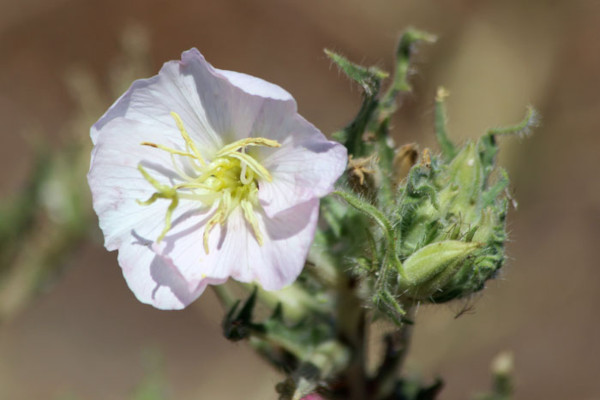
Antioch Dunes evening primrose. Photo Credit: Robin Boothby / USFWS
Insects such as butterflies, bees, and beetles are known as pollinators, and they play an important role in supporting the state’s plant diversity. Pollinators transfer pollen between plants helping them to reproduce. Another group of important pollinators are birds! A bird/pollinator that you may be familiar with is the tiny yet mighty hummingbird. You probably (hopefully!) have seen hummingbirds speeding through your yard, buzzing between flowers drinking nectar to fuel their metabolism. They have long bills with tube-like tongues to drink nectar, usually from trumpet shaped flowers like columbines and honeysuckle.
For protein, hummingbirds will eat insects caught during flight, talk about fast food! Many hummingbirds spend winter in Central America or Mexico and will migrate north to breeding grounds in the U.S. as early as February to late spring. Hummingbirds fly during the day to find nectar when flowers are open and bright to see. Hummingbirds and many migratory birds rely on native plants for their survival (by the way, Migratory Bird Day is May 8th!).
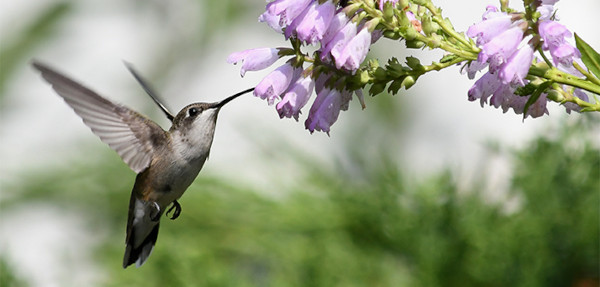
Female ruby-throated hummingbird. Photo Credit: Jim Hudgins / USFWS
When we conserve native plants, we help the many animals that depend on them for their survival. One of the animals that greatly benefit by native plants are us, good ‘ol humans. Because native plants are adapted to the soil and temperature conditions in a particular area they develop deep roots that can cling onto soil, preventing erosion and landslides on steep slopes. Their extensive roots systems keep watersheds clean; they are like filters that absorb polluted water before it enters waterways. And since many California plants are drought tolerant and use less water than non-native plants, they help recharge groundwater. It is important for us to conserve native plants and help them thrive.
Imagine a world where you didn’t see a California Poppy to brighten your day? That’s not a world we have to live in. Enjoy your native plants especially when they bloom and show off their radiance. Go wild for wildflowers! Visit your local nursery to buy native plants and plant them around your home. Bring happiness and life to your community with our beloved native plants.
Sources:
California Department of Fish and Wildlife. “Native Plants.” CDFW Prod, wildlife.ca.gov.
California Department of Fish and Wildlife. “Statewide Action Plan 2015 | A Conservation Legacy for Californians”, nrm.dfg.ca.gov.
U.S. Fish and Wildlife Service. “Antioch Dunes | About the Refuge”, www.fws.gov/refuge/Antioch_Dunes
National Park Service. “Pollinators - Hummingbirds”, www.nps.gov
